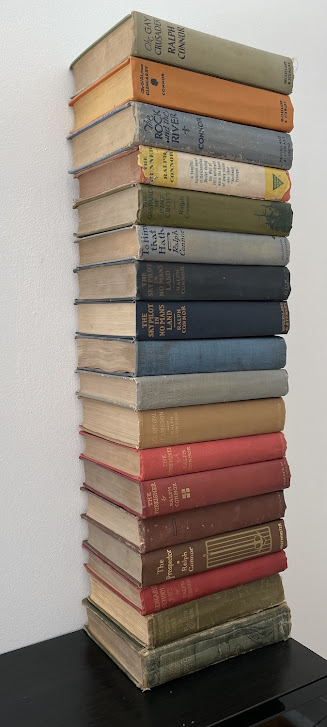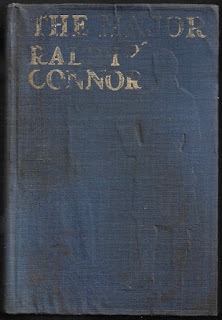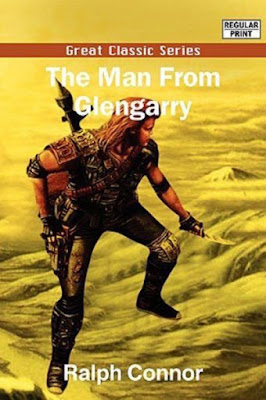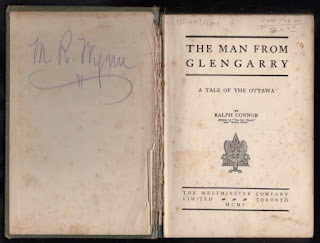Glengarry School Days:
A Story of the Early Days in Glengarry
Ralph Connor [pseud. Rev. Charles W. Gordon]
Toronto: Westminster, 1902
My mother was a great reader. Her typical day began by pouring over the Montreal
Gazette during breakfast. When finished, she'd turn to a little booklet that provided a passage from the Bible with a brief commentary. The books she read dealt primarily with politics and the environment. In her mind, religion, politics and the environment were inextricably linked.
My mother never expressed much interested in fiction. I remember her reading
Five Smooth Stones, Ann Fairbairn's 1966 bestseller, but I'm certain this was only because someone once gave her a copy as a Christmas gift.
Five Smooth Stones is 932 pages long. She was a good friend.
The only other fiction I remember my mother reading was
I Am Barabbas, a religious historical novel written by Laurence H. Blackburn (author of
God Wants You to Be Well and
The Evaluation of Physiological Syncope in Aviation Personnel). I'm sure there were other novels. Her copy of Erskine Caldwell's
Tobacco Road, the 1946 Collins White Circle Edition, sits on my shelves.
Strange to think she bought this as an eighteen-year-old. Tastes change, I suppose. People, too.
Glengarry School Days is the only Canadian novel that I know for a fact my mother read. I have memories of her telling us – my sister and I – whenever we passed through Glengarry County on annual visits to our Upper Canadian cousins. Of the novel itself, my mother said nothing. Having read it now myself, I wonder how much she remembered?
Published in 1902, the year after
The Man from Glengarry,
Glengarry School Days is not so much a sequel as filler. It takes place during the same time period as the earliest chapters of the former, though you'd never know it. The characters are familiar – Rev Murray, Mrs Murray, Hughie Murray, and Ranald Macdonald, to name just four – but no references are made to the events of
The Man from Glengarry. There is no overarching narrative, rather the book consists of a series of episodes, as reflected in the chapter titles: The Spelling-Match, The New Master, The Bear Hunt, etc.
Judith Skelton Grant and others suggest that
Glengarry School Days is drawn the author's memories of the county and the one-room schoolhouse he attended as a child. I'm sure they're right, and it is in this the novel's strengths and flaws lie. Connor's attention to detail may be of value to cultural historian, but it stalls the plot, as in this early passage:
The afternoon was given to the more serious
part of the school work – writing, arithmetic, and
spelling, while, for those whose ambitions extended
beyond the limits of the public school, the master
had begun a Euclid class, which was at once his
despair and his pride. In the Twentieth school of
that date there was no waste of the children's time
in foolish and fantastic branches of study, in showy
exercises and accomplishments, whose display was
at once ruinous to the nerves of the visitors, and to
the self-respect and modesty of the children. The
ideal of the school was to fit the children for the
struggle into which their lives would thrust them, so that the boy who could spell and read and cipher
was supposed to be ready for his life work. Those
whose ambition led them into the subtleties of
Euclid's problems and theorems were supposed to
be in preparation for somewhat higher spheres of life.
Schoolhouse aside, the unifying element of the novel is religion. As in
The Man from Glengarry, it is the flawless, saintly Mrs Murray – and not her ordained husband – who serves as spiritual guide, leading boys and young men the path they will follow tho become clergymen. Their number includes cynical city boy Jack Craven, the last in a line of schoolteachers.
No more drinking for Jack!
In this novel, Mrs Murray's example is echoed in Mrs Finch, the mother of Hughie's good friend Thomas. An older boy, Thomas serves as a role model to young Hughie, much like Ranald Macdonald did in
The Man from Glengarry (in which, it should be noted, Thomas is not so much as mentioned). The two are similar in both character and family, the most obvious difference being that Ranald's mother is dead. Thomas's mother is still alive, though she is suffering a long, slow death from breast cancer. Mrs Finch nearly makes it to the end of the novel, expiring with just two pages to go.
I spoil nothing. You can see it coming.
The deathbed scene is melodramatic and jarring, particularly given the subtlety of the message imparted throughout
Glengarry School Days. You see, it is Thomas, not his sisters, who nurses Mrs Finch through her final months. Connor wants to demonstrate that one can be masculine and muscular – or, best of all, a Muscular Christian – and still be tender, gentle and loving.
A good son, that Thomas Finch. A role model for us all.
Homage: The fourth chapter begins with a conversation between Mr and Mrs Bushy (not Busby), two squirrels who live by the schoolhouse in an old beech tree. Lasting two pages, the exchange is entirely out of place. I was reminded of nothing so much as the animal stories Charles G.D. Roberts and Ernest Thompson Seton – particularly
Bannertail – which, of course, was Connor's intent.
Trivia: All UK editions – four that I can count – were published by Hodder & Stoughton under the title
Glengarry Days.
Object: I own two copies. The one I read appears to be the first Canadian edition... or so a bookseller once claimed. I have no reason to doubt. It also appears to have once belonged to a man – or, perhaps, boy – named Dougal Sinclair. Might this be the same Dougal Sinclair, a 21-year-old dry goods clerk, who was recorded in the 1901 census as living in Glengarry? I like to think so.
Three hundred and fifty pages in olive green cloth, I bought it four years ago in London, Ontario. Price: $2.00.
Access: Once a mainstay, today's Canadian public library patrons will find that themselves served only by this country's very largest. Fortunately, copies of
Glengarry School Days are held by nearly every academic institution in the country.
There have been numerous Canadian, American and British editions. Used copies are plentiful and cheap. I expect few booksellers bother listing it online. My advice is to go for one of the Westminster editions.
The novel was a longstanding title in the New Canadian Library, and somehow survived as part of the series to the end. The last NCL edition – price: $17.95 – is still listed on the publisher's website. Do not bother looking for it in our national chain; not one of its 231 stores stocks a copy.
Related posts:










































